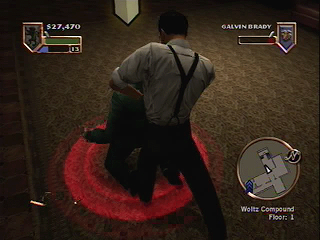Cyborgs are a fixture of cyberpunk games like Deus Ex and Shadowrun Returns, tragic figures who’ve made a Faustian bargain, trading humanity for machine capabilities. But I think they’re actually sort of ridiculous figures to present in contemporary video games, because they fly in the face of the joining of machine and human that those very games rely on and take for granted. I think what we need instead is games that engage with the machine-humans we already are.
The recent release of Shadowrun Returns has made me once again think about cyberpunk as a genre of fiction, and what it means. Cyberpunk began as a reaction against earlier utopian sci-fi that envisaged a Buck Rogers future where technology has eliminated most of the problems a contemporary reader of the 40s or 50s would be familiar with. In contrast, cyberpunk depicts a future in which corporate greed has run rampant, where humans and machines meld together, and where the outcome is decidedly not for the better. It’s often said that cyberpunk is based around the idea that technology will not solve our problems, only create new ones or perpetuate existing ones.

But in many ways, the future that cyberpunk envisaged from the early 80s through the early 90s already looks ridiculous. It’s a retrofuture, a paleofuture, a future as imagined by people who, for all their efforts could not move past the assumptions and ideas of their era. And their era is rapidly fading into the past. Neuromancer, William Gibson’s seminal cyberpunk novel, is as old to us now as the future of the pulp sci-fi magazines was to him when he wrote the book.
One of the most persistent tropes of cyberpunk fiction is that of the cyborg, a blending of man and machine to create an entity that might have greater capabilities in certain areas, but also an entity that, in almost all its fictional appearances, is inescapably less than human as a result. In Deus Ex: Human Revolution (which I’ve also been replaying recently), Adam Jensen is resentful of his cybernetic augmentations (he never asked for this) for this reason. The setting depicts the conjoining of human and machine as fundamentally unnatural, requiring special drugs to combat the body’s rejection.
Cyborgs are generally presented in cyberpunk fiction as a grim spectre of a machine-dominated humanity of the future, and this is reinforced in video games through mechanics like Shadowrun Returns’ Essence mechanic. In Shadowrun Returns, the more cyberware a character has installed, the less they’re capable of using magic. This undoubtedly serves a game-balancing purpose, but it also delivers a clear moral message about cyberware, because magic is framed in Shadowrun as the deeper, underlying truth of the world. What better argument against the cyborg could there be than that using cyberware disconnects you from what is true and good in the world?
But I’d argue this negative view of the cyborg is impossible to reconcile with our present-day reality, let alone our future, because the fact is we’re already joined with machines. Just like the jetpacks and spaceships of Buck Rogers, cyberpunk fiction’s depiction of cyborgs is as much an outmoded concept as the rest of its vision of the future. The fact is, many of the changes in the world that cyberpunk predicted have indeed eventuated, but the world hasn’t turned out the way cyberpunk argued it would. You could certainly argue that corporate power has run rampant, but whether this has created a dystopian present or not, it’s certainly not the simplistic, relatively obvious dystopia of cyberpunk fiction. Likewise, I would argue that we are already joined with machines, but that this has not robbed us of our fundamental essence or humanity.
Playing a video game is an entirely normal and mundane activity that illustrates what I mean: when I play a game like Shadowrun Returns or Deus Ex, I’m engaging with a machine. I input into the game, the machine, via keyboard or game pad, and the game processes my inputs and returns to me whatever feedback is produced by its systems as a result of my inputs. I pull the trigger on a controller, and I see and hear a gun firing within the game’s fictional world, and feel the controller vibrate in my hand. It’s important to emphasise the very physical nature of this engagement with the machine: the controller is essentially an extension of the game’s body, and I’m physically pulling the trigger. Likewise, the screen and its speakers are organs it uses to communicate with me, to talk to me, to produce lights and sounds that I process with my eyes and ears. I receive the inputs the game delivers to me, and I respond with my body, and it does the same. The game and I are very clearly interacting in a way that involves both of our bodies, and more specifically, it involves both of our bodies combining in a very particular way that we call “playing a video game”.
It’s this combination of our bodies that produces the experience of playing a video game. When I play a video game, I’m having an experience that’s impossible to have without the involvement of a machine. And likewise, the machine can’t very well play itself in anything like the same way. It takes both, a combination of the two, in the act of a human playing a video game, to create this experience. This combination is obviously a conjunction of human and machine bodies, joining to create something that neither can create on their own. What else can we call this but a cyborg?
Video games are obviously not the only place this kind of conjoining of human and machine occurs. For example, what is Google but an artificial memory, that can call up information at will? What is writing, for that matter, but an artificial aid to memory, an augmentation of human capabilities? This is hardly a new understanding of the concept of the cyborg: feminist theorist Donna Haraway discusses cyborgs in this way, and philosopher Bruno Latour discusses a very similar concept that he calls the hybrid. Even applying this idea to the act of playing a video game isn’t new, as a number of critics and researchers have used it to further understand how we play games, and what precisely it is that games do when we play them. But even though it’s not an understanding of cyborgs that’s taken root in popular culture, it’s definitely one that helps us understand the world we live in, and the relationships we humans have with non-human entities like machines. And I certainly think there’s a strong case that it’s fundamental to understanding how we play video games.
Doesn’t it seem ridiculous, then, that games like Shadowrun and Deus Ex still treat the idea of the cyborg as a tragic or repulsive one, given that these video games can only exist and function because this cyborg exists? Isn’t it ridiculous that these games exist as part of cyborgs, yet they try to say that cyborgs are abhorrent, rather than mundane and everyday?
What I’d really like to see is games that go beyond this absurd dichotomy of “man and machine”. It’s absurd for games to continue treating the conjunction of humans and machines as strange or wrong or somehow defying a universal order. It’s absurd because they defy it in their very operation. I want to see games that engage with the fact that the cyborg already exists. I want to see video games that engage with the player as part of a conjunction of human and machine, because they already have be that cyborg in order to be playing the game at all.
There are already a number of noteworthy games that go some way in this direction. The widely-known Psycho Mantis fight in Metal Gear Solid, for example, requires that the player manipulate the game’s inputs on a very physical level. This forces the player to acknowledge, at least to some degree, that they are experiencing the game as part of a conjunction with the game as a machine. There are also numerous games that play with player perceptions, showing the player things that might not match the reality of the fictional worlds they construct. This is relevant because such tricks rely on making a distinction between what the player sees in conjunction with the machine, and the fictional reality of a game. These are all notable and worthy steps in the right direction.
There are also many games that engage with the player bodily, and I’m not just talking about the current generation of motion-controlled games, either. In fact, one of my favourite examples of what I mean by engaging the player bodily comes from the video game adaptation of The Godfather, on the Xbox. The Godfather allows players to perform a variety of execution moves, through various combinations of buttons and thumbstick movements, but there’s one execution move which demands a particularly physical involvement on the part of the player. The garrotte move is performed by pulling both triggers on the Xbox controller, and also pushing in both thumbsticks. This requires the player to grip and squeeze the controller in order to perform the move, mimicking the act of strangulation in a very striking way, until the character they’re executing is dead. Motion control titles frequently involve the player bodily, but rarely in quite so dramatic or physical a fashion.
But both these kinds of engagement, while important steps on the right track, are ultimately a bit trivial. At best, they serve to make the player aware of their involvement and engagement with the machine. However, the truth is that even video games like these rarely, if ever, go beyond that. They raise the question of the player’s engagement with the machine, and then they move on. They don’t explore it a in any kind of sophisticated way. This is hardly sufficient for a present day in which the fact of the cyborg’s existence is so mundane that it’s fundamental to the very act of playing a video game. They’re a cute throwaway, pointing out something that’s actually important just to get a cheap laugh, like the radio conversation in Metal Gear Solid 3 where a character in 1964 speculates about people playing interactive movies in the future.
Where are the games that engage with the fact of the cyborg, beyond acknowledging or highlighting it? Where are the games that explore this in greater depth? What would a game have to do in order to explore this? Would it even be possible in the contemporary AAA space, or will it be solely the domain of experimental games? Even then, where are they?










Shadowrun’s a really interesting case, I think, because if you read the role playing game, things get exponentially sill as they try to explain away things that they thought were good ideas in 1989. Returns is also interesting in terms of how it presents cyborgs, because it cuts out one of Shadowrun’s coolest character concepts, the Technomancer, who are people who commune directly with computers. It’s mechanically obvious why they did it–Technomancers, even in Shadowrun tabletop, play way differently than normal people–but yeah.
Also: not sure I agree with your eventual point, because I think a medium where you have to interact so closely with a machine is perhaps the best medium to express the distrust of machines. Metal Gear Solid 2, I think, takes Psycho Mantis and writes it (awkwardly) across the sky: even if we are part machine, machines can destroy us.
To be honest, I’m not sure I agree with the point either. You can put a computer down. You can put a video game controller down. You can put a smartphone down. Those things may be extensions of ourselves, but that just makes them tools, and we’ve been using tools for millennia. Trying to use this to define “cyborg” tortures the word into a quivering jelly of meaninglessness.
Cyborgs are different. The whole idea is that it’s technology that is now part of your body, that you CAN’T put down. It’s a very specific variation on body horror, and one that’s quite a bit scarier because it’s utterly plausible. Not that there aren’t benefits, and not that the benefits outweigh the costs. We still have every reason to be leery of it.
Pingback: New Games Online » This Week in Video Game Criticism: From Corrypt to objectivity
Yeah, Craig has the right of it: Humans have always used tools, and machines and electronics are merely more complicated tools. The concept of a Cyborg has always been the joining of a tool to ourselves in a permanent way, often in a way that supplants part of our biology instead of just adding to it. You could say that we’re cyborgs when our reliance on Google partially replaces our ability to remember things naturally, but not when we merely engage with a game.
Videogames existed in the 80’s too. I don’t think they were what people had in mind while the cyberpunk genre developed.
It is true that fictional cyborgs no longer seem horrific, due to how pervasive technology really is. Actual artificial legs and arms are more and more advanced, and many people never part from their smartphones. But I don’t think the concept of “cyborg” no longer has any meaning, as in your definition.
The thing is, I don’t think permanence, or degree of permanence, is what makes a cyborg. At best, that’s a pretty dodgy definition of a cyborg, and leads to “no true Scotsman” definitions of a cyborg. A cyborg doesn’t have to look like a cyberpunk cyborg. That’s my whole point.
I think what matters is the degree to which we become entangled with technology that matters. I think what matters is how difficult to dis-entangle ourselves from technology it is. That, to me, is what makes a cyborg. And when you look at it like that, there are a *lot* of technologies we’re already irretrievably entangled with. Let’s start with the most basic one: language.
What we’re talking about here is re-interpreting the cyborg concept, because the cyberpunk concept of cyborgs is really incredibly tunnel-visioned. Thinking about it like that is kind of what Haraway and Latour do, and they develop the idea far more than I could in this blog post.
So the point I wanted to make here is, the cyberpunk concept of a cyborg as this horrifying or tragic figure is really blinkered to the ways we already do, and always have, used technology. And it’d be nice if video games could acknowledge that, and maybe draw on it to produce more interesting visions of technology-use, rather than regurgitating these tired old tropes.
Pingback: A(s)century, Philp K. Dick and Videogames | bigtallwords